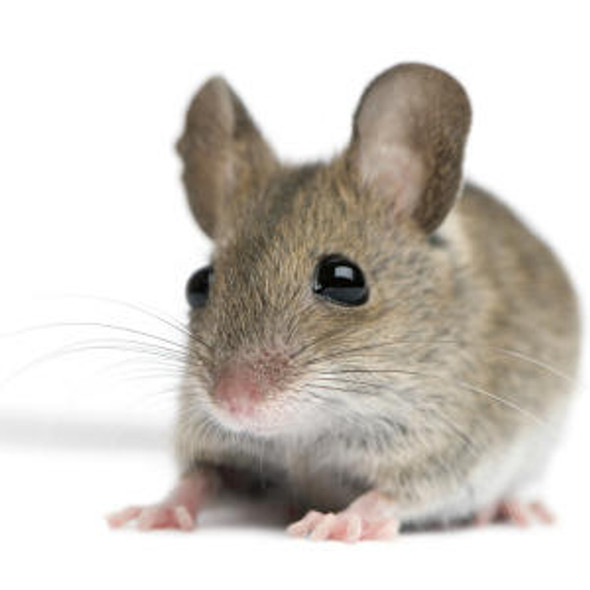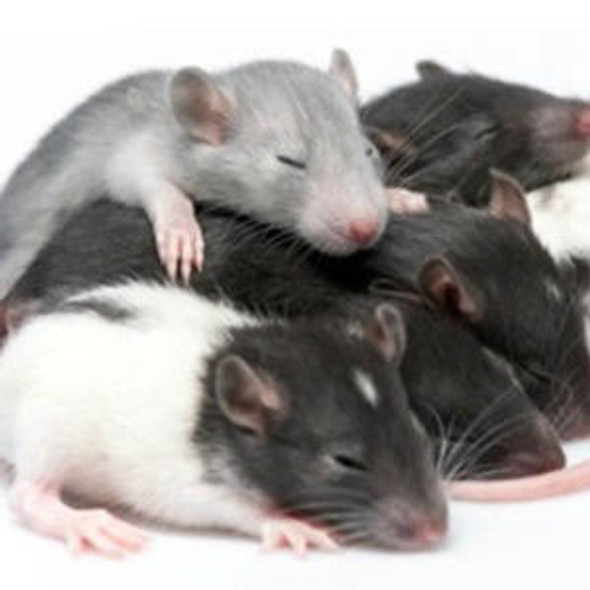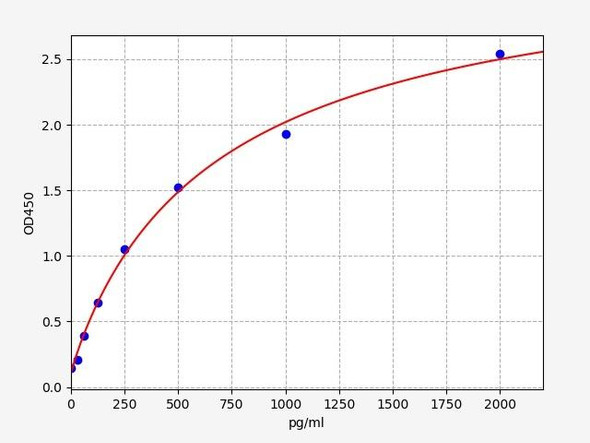Rat TGFBR1(TGF-beta receptor type-1) ELISA Kit
- SKU:
- RTFI01272
- Product Type:
- ELISA Kit
- Size:
- 96 Assays
- Uniprot:
- P80204
- Sensitivity:
- 4.688pg/ml
- Range:
- 7.813-500pg/ml
- ELISA Type:
- Sandwich ELISA, Double Antibody
- Synonyms:
- TGFBR1, AAT5, ALK5, MSSE, SKR4, ALK-5, LDS1A, LDS2A, TGFR-1, ACVRLK4, Transforming growth factor-beta receptor type I, TGF-beta receptor type I, TbetaR-I, TGF-beta type I receptor, Serine, threonine-protein kinase receptor R4, SKR4, Activin A recepto
- Reactivity:
- Rat
Description
| Product Name: | Rat TGFBR1 (TGF-beta receptor type-1) ELISA Kit |
| Product Code: | RTFI01272 |
| Size: | 96 Assays |
| Target: | Rat TGFBR1 |
| Alias: | TGFBR1, AAT5, ALK5, MSSE, SKR4, ALK-5, LDS1A, LDS2A, TGFR-1, ACVRLK4, Transforming growth factor-beta receptor type I, TGF-beta receptor type I, TbetaR-I, TGF-beta type I receptoR |
| Reactivity: | Rat |
| Detection Method: | Sandwich ELISA, Double Antibody |
| Sensitivity: | 4.688pg/ml |
| Range: | 7.813-500pg/ml |
| Storage: | 4°C for 6 months |
| Note: | For Research Use Only |
| Recovery: | Matrices listed below were spiked with certain level of Rat TGFBR1 and the recovery rates were calculated by comparing the measured value to the expected amount of Rat TGFBR1 in samples. Please contact us for more information. |
| Linearity: | The linearity of the kit was assayed by testing samples spiked with appropriate concentration of Rat TGFBR1 and their serial dilutions. The results were demonstrated by the percentage of calculated concentration to the expected. Please get in contact for more information. |
| Intra-Assay: | CV <8% |
| Inter-Assay: | CV <10% |
| Uniprot: | P80204 |
| UniProt Protein Function: | TGFBR1: a TKL kinase of the serine/threonine-protein kinase receptor (STKR) family. R1 and R2 TGF-beta receptors dimerize after binding TGF-beta at the cell surface. Found in all tissues; most abundant in placenta and least abundant in brain and heart. |
| UniProt Protein Details: | Protein type:EC 2.7.11.30; Kinase, protein; Membrane protein, integral; Protein kinase, Ser/Thr (receptor); Protein kinase, TKL; Receptor, misc.; STKR family; TKL group; Type1 subfamily Chromosomal Location of Human Ortholog: 5q22 Cellular Component: apical plasma membrane; basolateral plasma membrane; caveola; cell; cell surface; endosome; intracellular membrane-bound organelle; lipid raft; membrane; plasma membrane; protein complex; receptor complex; tight junction Molecular Function:ATP binding; growth factor binding; protein complex binding; protein heterodimerization activity; protein kinase activity; protein serine/threonine kinase activity; punt binding; receptor binding; receptor signaling protein activity; receptor signaling protein serine/threonine kinase activity; SMAD binding; transforming growth factor beta binding; transforming growth factor beta receptor activity; transforming growth factor beta receptor activity, type I; ubiquitin protein ligase binding Biological Process: activation of MAPKK activity; activin receptor signaling pathway; aging; angiogenesis; anterior/posterior pattern formation; artery morphogenesis; blastocyst development; cell motility involved in cell locomotion; collagen fibril organization; embryo implantation; embryonic cranial skeleton morphogenesis; endothelial cell activation; endothelial cell migration; epithelial to mesenchymal transition; germ cell migration; gut development; heart development; in utero embryonic development; kidney development; lens development in camera-type eye; lung development; male gonad development; mesenchymal cell differentiation; negative regulation of apoptosis; negative regulation of chondrocyte differentiation; negative regulation of endothelial cell differentiation; negative regulation of endothelial cell proliferation; neuron fate commitment; organ regeneration; palate development; parathyroid gland development; peptidyl-serine phosphorylation; peptidyl-threonine phosphorylation; pharyngeal system development; positive regulation of cell growth; positive regulation of cell migration; positive regulation of cell motility; positive regulation of cell proliferation; positive regulation of endothelial cell proliferation; positive regulation of filopodium formation; positive regulation of protein kinase B signaling cascade; positive regulation of stress fiber formation; positive regulation of transcription, DNA-dependent; post-embryonic development; protein amino acid autophosphorylation; protein amino acid phosphorylation; regulation of cardiac muscle cell proliferation; regulation of gene expression; regulation of protein binding; regulation of protein ubiquitination; regulation of transcription, DNA-dependent; response to electrical stimulus; response to estrogen stimulus; response to hypoxia; response to organic cyclic substance; response to toxin; signal transduction; skeletal development; skeletal morphogenesis; thymus development; transforming growth factor beta receptor signaling pathway |
| NCBI Summary: | forms a heteromeric receptor complex with TGF-beta type II receptor that binds TGF-beta and mediates TGF-beta signalling [RGD, Feb 2006] |
| UniProt Code: | P80204 |
| NCBI GenInfo Identifier: | 417220 |
| NCBI Gene ID: | 29591 |
| NCBI Accession: | P80204.1 |
| UniProt Related Accession: | P80204 |
| Molecular Weight: | 56,000 Da |
| NCBI Full Name: | TGF-beta receptor type-1 |
| NCBI Synonym Full Names: | transforming growth factor, beta receptor 1 |
| NCBI Official Symbol: | Tgfbr1 |
| NCBI Official Synonym Symbols: | Alk5; Skr4; Tgfr-1; tbetaR-I |
| NCBI Protein Information: | TGF-beta receptor type-1 |
| UniProt Protein Name: | TGF-beta receptor type-1 |
| UniProt Synonym Protein Names: | Serine/threonine-protein kinase receptor R4; SKR4; TGF-beta type I receptor; Transforming growth factor-beta receptor type I; TGF-beta receptor type I; TbetaR-I |
| Protein Family: | TGF-beta receptor |
| UniProt Gene Name: | Tgfbr1 |
| Step | Procedure |
| 1. | Set standard, test sample and control (zero) wells on the pre-coated plate respectively, and then, record their positions. It is recommended to measure each standard and sample in duplicate. Wash plate 2 times before adding standard, sample and control (zero) wells! |
| 2. | Aliquot 0.1ml standard solutions into the standard wells. |
| 3. | Add 0.1 ml of Sample / Standard dilution buffer into the control (zero) well. |
| 4. | Add 0.1 ml of properly diluted sample ( Human serum, plasma, tissue homogenates and other biological fluids.) into test sample wells. |
| 5. | Seal the plate with a cover and incubate at 37°C for 90 min. |
| 6. | Remove the cover and discard the plate content, clap the plate on the absorbent filter papers or other absorbent material. Do NOT let the wells completely dry at any time. Wash plate X2. |
| 7. | Add 0.1 ml of Biotin- detection antibody working solution into the above wells (standard, test sample & zero wells). Add the solution at the bottom of each well without touching the side wall. |
| 8. | Seal the plate with a cover and incubate at 37°C for 60 min. |
| 9. | Remove the cover, and wash plate 3 times with Wash buffer. Let wash buffer rest in wells for 1 min between each wash. |
| 10. | Add 0.1 ml of SABC working solution into each well, cover the plate and incubate at 37°C for 30 min. |
| 11. | Remove the cover and wash plate 5 times with Wash buffer, and each time let the wash buffer stay in the wells for 1-2 min. |
| 12. | Add 90 µL of TMB substrate into each well, cover the plate and incubate at 37°C in dark within 10-20 min. (Note: This incubation time is for reference use only, the optimal time should be determined by end user.) And the shades of blue can be seen in the first 3-4 wells (with most concentrated standard solutions), the other wells show no obvious color. |
| 13. | Add 50 µL of Stop solution into each well and mix thoroughly. The color changes into yellow immediately. |
| 14. | Read the O.D. absorbance at 450 nm in a microplate reader immediately after adding the stop solution. |
When carrying out an ELISA assay it is important to prepare your samples in order to achieve the best possible results. Below we have a list of procedures for the preparation of samples for different sample types.
| Sample Type | Protocol |
| Serum: | If using serum separator tubes, allow samples to clot for 30 minutes at room temperature. Centrifuge for 10 minutes at 1,000x g. Collect the serum fraction and assay promptly or aliquot and store the samples at -80°C. Avoid multiple freeze-thaw cycles. If serum separator tubes are not being used, allow samples to clotovernight at 2-8°C. Centrifuge for 10 minutes at 1,000x g. Removeserum and assay promptly or aliquot and store the samples at-80°C. Avoid multiple freeze-thaw cycles. |
| Plasma: | Collect plasma using EDTA or heparin as an anti-coagulant. Centrifuge samples at 4°C for 15 mins at 1000 — g within 30 mins of collection. Collect the plasma fraction and assay promptly or aliquot and store the samples at -80°C. Avoid multiple freeze-thaw cycles.Note: Over haemolysed samples are not suitable for use with this kit. |
| Urine & Cerebrospinal Fluid: | Collect the urine (mid-stream) in a sterile container, centrifuge for 20 mins at 2000-3000 rpm. Remove supernatant and assay immediately. If any precipitation is detected, repeat the centrifugation step. A similar protocol can be used for cerebrospinal fluid. |
| Cell Culture Supernatant: | Collect the cell culture media by pipette, followed by centrifugation at 4°C for 20 mins at 1500 rpm. Collect the clear supernatant and assay immediately. |
| Cell Lysates: | Solubilize cells in lysis buffer and allow to sit on ice for 30 minutes. Centrifuge tubes at 14,000 x g for 5 minutes to remove insoluble material. Aliquot the supernatant into a new tube and discard the remaining whole cell extract. Quantify total protein concentration using a total protein assay. Assay immediately or aliquot and store at ≤ -20°C. |
| Tissue Homogenates: | The preparation of tissue homogenates will vary depending upon tissue type. Rinse tissue with 1X PBS to remove excess blood & homogenizein 20ml of 1X PBS (including protease inhibitors) and store overnight at ≤ -20°C. Two freeze-thaw cycles are required to break the cell membranes. To further disrupt the cell membranes you can sonicate the samples. Centrifuge homogenates for 5 mins at 5000xg. Remove the supernatant and assay immediately or aliquot and store at -20°C or-80°C. |
| Tissue Lysates: | Rinse tissue with PBS, cut into 1-2 mm pieces, and homogenize with a tissue homogenizer in PBS. Add an equal volume of RIPA buffer containing protease inhibitors and lyse tissues at room temperature for 30 minutes with gentle agitation. Centrifuge to remove debris. Quantify total protein concentration using a total protein assay. Assay immediately or aliquot and store at ≤ -20 °C. |
| Breast Milk: | Collect milk samples and centrifuge at 10,000 x g for 60 min at 4°C. Aliquot the supernatant and assay. For long term use, store samples at -80°C. Minimize freeze/thaw cycles. |










